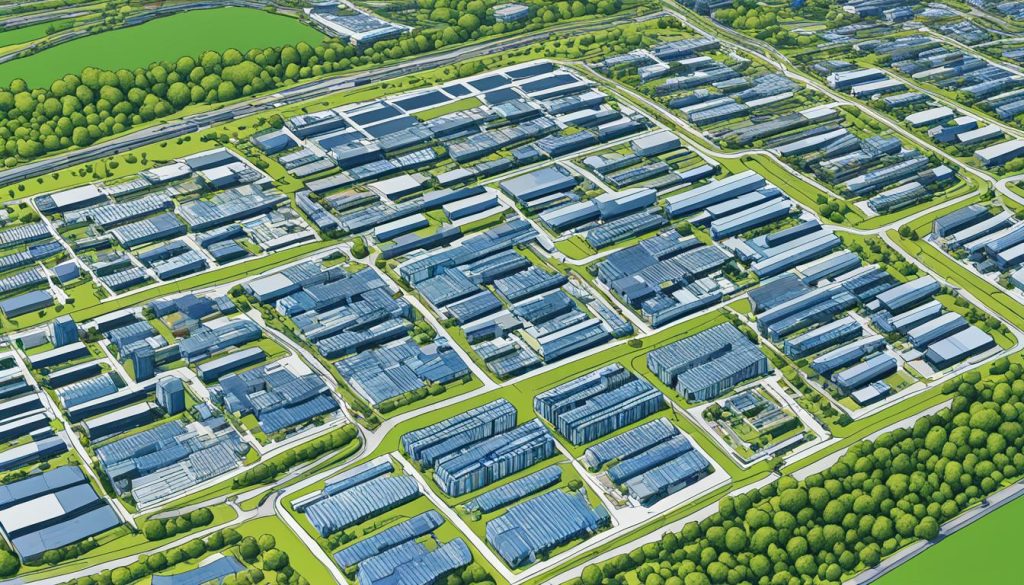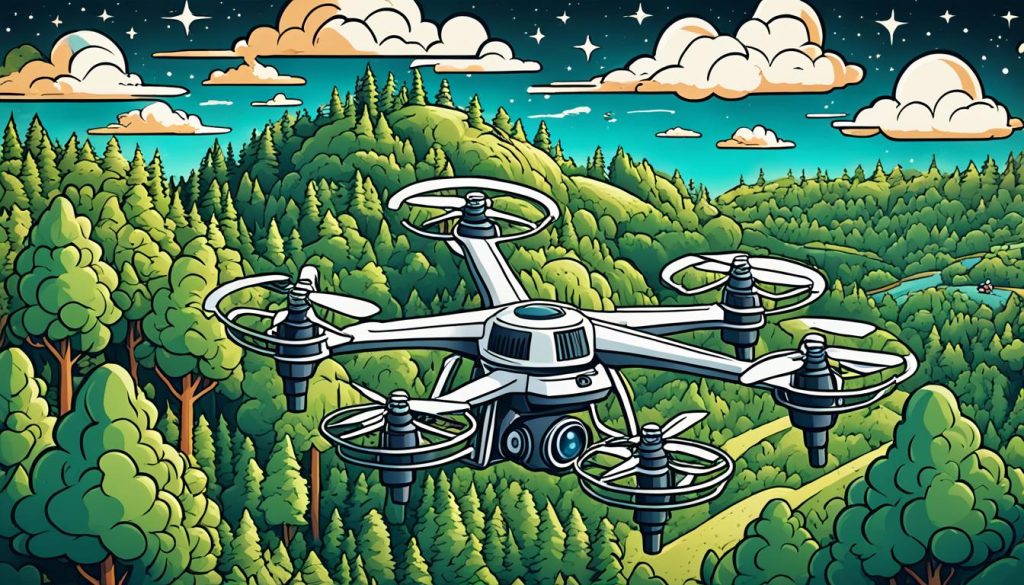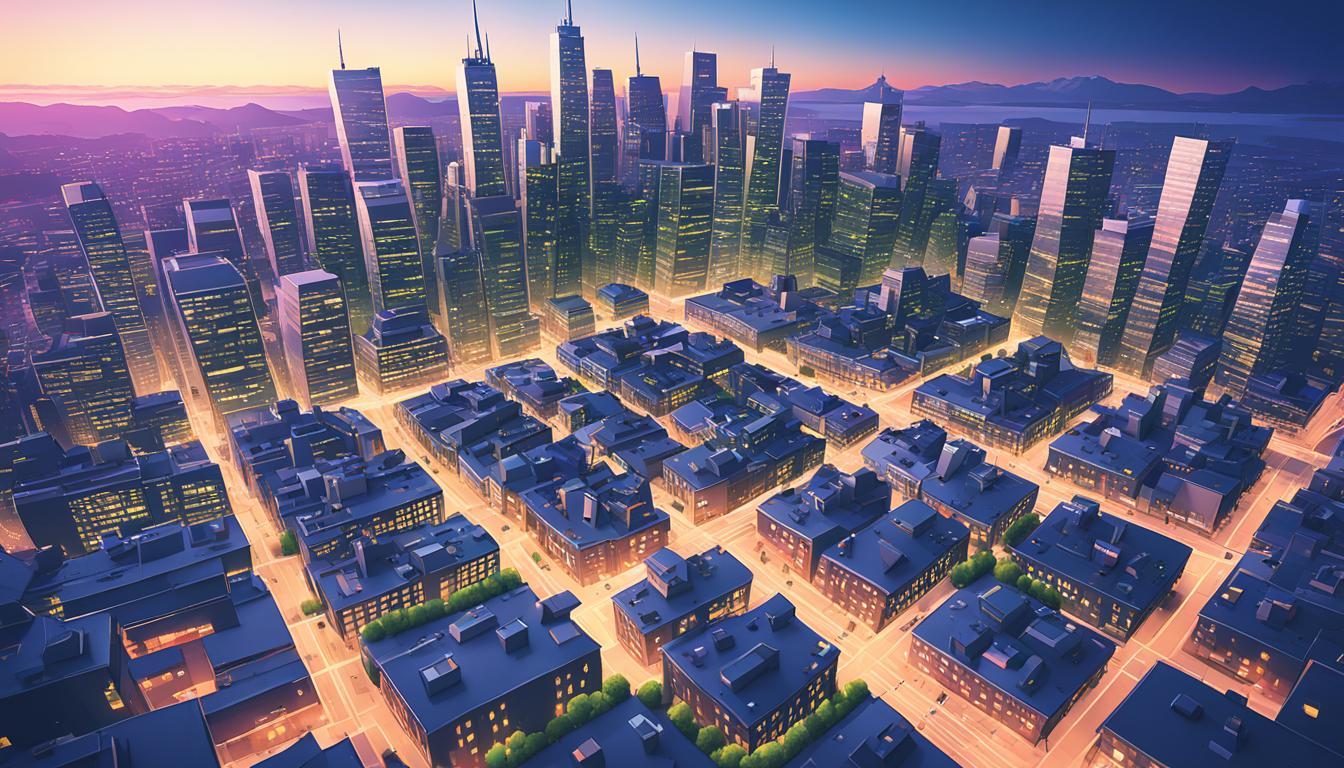You can make your low-light drone photos better with AI noise reduction. This tech turns blurry, grainy shots into clear, detailed images. It helps you capture the beauty of nighttime scenes.
AI tools use deep learning to spot and remove noise in your drone photos. These advanced methods give you clear, professional-looking shots even in tough lighting. They cut down on graininess and make details sharper, making your nighttime drone shots pop.
Exploring AI noise reduction for drone photos shows how it fixes blurry, pixelated images. This tech adds fine details to textures and lines while keeping the shot’s original look. With these AI tools, your nighttime drone photos will be clearer and more detailed, showing off the beauty from above.
Understanding the Challenges of Low-Light Drone Photography
Low-light drone photography has its own set of challenges. Consumer-grade drones often find it hard in dim conditions because of their small sensors. This means they struggle with ISO noise and recovering shadow details.
When you fly your drone at night or in low light, you’ll see grainy images even at low ISO settings. This happens because the small sensors can’t capture enough light. So, the camera boosts sensitivity, which adds unwanted noise.
Recovering shadow details is tough in these situations. Trying to brighten dark areas in post-processing can make the noise worse. This can make your images look grainy and less professional.
To overcome these problems, many photographers use image stacking. This involves taking multiple photos of the same scene. It helps reduce random noise while keeping important details. This method works because noise appears randomly in each shot.
| Challenge | Cause | Effect | Potential Solution |
|---|---|---|---|
| High ISO Noise | Small sensor size | Grainy images | Use lower ISO, longer exposure |
| Poor Shadow Detail | Limited dynamic range | Loss of information in dark areas | Exposure bracketing |
| Motion Blur | Slow shutter speeds | Soft, unclear images | Stabilization techniques |
| Color Inaccuracy | Low light conditions | Unnatural color rendition | Manual white balance adjustment |
Knowing these challenges is key to improving your low-light drone photography. With the right techniques and tools, you can beat these obstacles and capture amazing nighttime aerial shots.
The Power of AI in Image Processing
AI has changed the game in image processing, especially for drone photography. It makes low-light images better by reducing noise and enhancing quality. Let’s see how AI can transform your aerial shots.
Deep Learning for Image Denoising
Deep learning algorithms look at thousands of images to learn about noise patterns. They figure out what’s important and what’s not. When used on your drone photos, these algorithms get rid of graininess while keeping the important parts.
AI-Powered Image Processing Techniques
AI doesn’t just reduce noise. It can also make colors brighter, adjust contrast, and sharpen details. These changes work together to make your low-light drone photos look cleaner and more vibrant.
| Technique | Benefit |
|---|---|
| Noise Reduction | Removes graininess |
| Color Enhancement | Improves vibrancy |
| Detail Sharpening | Increases clarity |
Computational Photography Advancements
Computational photography takes AI even further. It combines several photos to make one high-quality image. This is great for drone photos in tough lighting, letting you capture beautiful night scenes with little noise.
Using these AI tools can greatly improve your drone photos in low light. Deep learning, image denoising, and computational photography work together to give you amazing control over your images. This means you can take stunning aerial shots even in the toughest conditions.
Selecting the Right AI Noise Reduction Software
Finding the best AI noise reduction software for your drone photos is key to improving image quality. There are many options, from well-known tools to apps made just for drones. Let’s look at some top picks to help you choose the right one for you.
Adobe Photoshop is a top choice for image processing with strong AI noise reduction. It has smart objects that let you adjust settings without losing quality. Photoshop’s AI can greatly improve low-light drone photos, keeping details sharp and reducing graininess.
The DJI Go app is great for drone fans. It has built-in tools for reducing noise, made just for DJI drones. You can process your photos right after taking them, which saves time. Its easy-to-use interface makes applying AI noise reduction simple.
| Software | Key Features | Best For |
|---|---|---|
| Adobe Photoshop | Smart objects, advanced editing | Professional photographers |
| DJI Go App | Drone-specific tools, quick processing | DJI drone users |
| Topaz DeNoise AI | Specialized noise reduction, batch processing | High-volume shooters |
When choosing AI noise reduction software, think about features like burst mode and image alignment. These are key for handling multiple shots from your drone. The best choice depends on what you need and your skill level.
Preparing Your Drone for Low-Light Captures
Mastering low-light drone photography takes careful prep and knowing your gear. Let’s look at key factors for better nighttime shots from above.
Optimal Camera Settings for Night Aerial Shots
For low-light shots, tweak your drone’s camera settings. Boost the ISO but watch out for noise. A slower shutter speed lets in more light but might blur motion. Open your aperture wide for the most light. Try different settings to find what works best:
| Setting | Recommendation | Consideration |
|---|---|---|
| ISO | 400-1600 | Higher values increase noise |
| Shutter Speed | 1/15 – 1/60 sec | Slower speeds may cause blur |
| Aperture | f/2.8 – f/4 | Widest available on your drone |
Utilizing Burst Mode for Multiple Exposures
Burst mode is great for low-light drone shots. It snaps many photos fast, boosting your odds of a clear image. Most drones can take 3-5 bursts in RAW. Turn on burst mode in your drone’s settings for great shots.
Importance of Drone Stability in Low-Light Conditions
For clear night shots, your drone needs to be stable. Use its built-in stabilization and fly in calm weather. A longer exposure with a still drone can capture light trails or star trails. But, even small moves can make low-light photos blurry.
Master these tips to take amazing low-light aerial photos. Next, we’ll see how AI can reduce noise in these shots.
Use AI Noise Reduction to Enhance Low-Light Drone Photos
AI noise reduction can turn low-light drone photos into stunning images. Your night shots will look amazing with the right tools and techniques. Let’s explore an AI noise reduction workflow to improve your aerial photography.
Begin by importing your burst images into Adobe Lightroom. This software is great for organizing and basic editing of your raw files. After picking the best shots, move to Photoshop for the next steps.
In Photoshop, load your chosen images as layers. This is where the AI noise reduction starts. Turn these layers into a Smart Object. This feature lets you edit without harming your original image.
Then, use the Stack Mode function. This method combines multiple exposures to reduce noise and keep details sharp. You get a cleaner, sharper image that highlights your low-light drone photos.
Image stacking is a key technique for reducing noise. By combining shots, you let the AI collect more data. This results in an image with less noise and more detail. It’s perfect for static scenes like cityscapes or landscapes.
Remember, practice is key. Try different numbers of images in your stack and adjust the AI settings. Soon, you’ll be taking amazing low-light aerial photos with little noise.
Step-by-Step Guide to AI Noise Reduction Workflow
AI noise reduction can make your low-light drone photos look better. This guide will show you how to import, edit, and optimize your images with AI algorithms.
Importing and Organizing Your Raw Files
First, import your raw files into a photo editing software like Lightroom or Adobe Camera Raw. Put your images into collections or folders for easy finding. Editing raw files gives you more flexibility and keeps your image quality high during noise reduction.
Applying AI Noise Reduction Algorithms
After importing your files, apply AI algorithms for noise reduction. Many software options use deep learning to spot and cut down noise while keeping details sharp. Pick your AI tool and tweak the settings for your image’s needs.

Fine-Tuning Results for Optimal Image Quality
After using AI noise reduction, fine-tune your images for the best quality. Adjust exposure, contrast, and sharpness to improve your photo’s look. Make sure fine details haven’t been smoothed out by the noise reduction.
| Step | Action | Purpose |
|---|---|---|
| 1 | Import raw files | Preserve image quality |
| 2 | Apply AI algorithms | Reduce noise |
| 3 | Fine-tune results | Optimize image quality |
By following this workflow, you can use AI noise reduction to improve your low-light drone photos. Try different settings and techniques to get the best results for your images.
Advanced Techniques: Combining AI Noise Reduction with Image Stacking
Using AI noise reduction with image stacking can take your drone photos in low light to the next level. This method lets you get stunning night scenes with less noise and more detail.
Begin by setting your drone camera to burst mode. Take several shots of the same scene, including ones that are too dark, just right, and too bright. This mix captures a broad range of light details.
Then, put your images into special software for stacking. These tools line up and merge your shots, cutting down on noise while keeping details sharp. You end up with one clear image that has a better range of light and less noise.
To get the best results, mix image stacking with AI noise reduction. Use AI on your stacked image to make details clearer and remove any noise left over. This combo is great for high ISO night shots and creating long exposure effects without slow shutter speeds.
| Technique | Benefits | Best Use Case |
|---|---|---|
| AI Noise Reduction | Removes digital noise, preserves details | Single exposure shots |
| Image Stacking | Reduces noise, improves dynamic range | Static scenes, star trails |
| Combined Approach | Superior noise reduction, enhanced details | Low-light landscapes, cityscapes |
Mastering this advanced technique lets you take amazing low-light drone photos with clear images and little noise. Try different exposure numbers and AI settings to find what works best for your shots.
Overcoming Common Challenges in AI-Enhanced Drone Photography
AI noise reduction opens new doors in drone photography, especially in low light. But, it comes with its own set of challenges. Knowing these can help you get amazing aerial shots even when it’s hard.
Dealing with Moving Subjects in Low-Light Scenes
Shooting moving things in dim light is tough. Fast-moving objects can blur or look ghostly in long shots. To fix this, use quicker shutter speeds and higher ISOs. Try burst mode to boost your chances of a clear photo. But, remember, AI might not handle fast movement well, so you might need to adjust things manually.
Balancing Noise Reduction and Detail Preservation
It’s key to balance noise reduction with keeping details sharp. Too much noise reduction can make your photos lose their fine textures and sharpness. Start with gentle settings and slowly increase them. Be careful with areas that have lots of details or patterns. Use masking tools to set different noise levels for different parts of your photo, keeping details sharp.

Addressing Artifacts from AI Processing
AI can sometimes add weird textures or change colors. To avoid this, don’t overdo it with the AI. Mix AI with traditional editing methods. If you see artifacts, try reducing the AI’s intensity or use masks on the affected areas. Always zoom in to spot any unwanted effects while editing.
By tackling these issues, you’ll get better quality in your AI-enhanced drone photos. With practice, you’ll get the hang of using AI noise reduction without losing the beauty of your aerial shots.
Comparing AI Noise Reduction to Traditional Methods
AI noise reduction has changed how we handle low-light drone photos. Traditional methods often struggle to remove noise without losing details. AI techniques offer a smarter way to handle this.
Using AI for noise reduction makes a big difference in image quality. These smart algorithms look at each pixel, find and cut noise, and keep important details.
| Aspect | Traditional Noise Reduction | AI Noise Reduction |
|---|---|---|
| Detail Preservation | Often blurs fine details | Maintains sharpness and texture |
| Processing Time | Generally faster | May take longer but yields better results |
| Flexibility | Limited adjustments | Offers fine-tuning options |
| Low-Light Performance | Struggles with extreme noise | Excels in challenging lighting conditions |
AI noise reduction is a game-changer for drone photos in low light. It cuts noise without losing sharpness, making it great for editing. This is especially useful for old DSLR photos or drone shots with lots of noise.
By using AI, you can get cleaner images even from shots taken at high ISO. Some AI tools can even make it seem like you took the photo at a lower ISO. This makes the difference between AI and traditional methods clear.
Conclusion: Elevating Your Drone Photography with AI Technology
AI-enhanced drone photography has changed how we take pictures from above at night. With artificial intelligence, you can now make your nighttime drone photos look amazing. This tech lets you do things you couldn’t before in the dark.
Using burst shooting and AI to reduce noise, you can take photos in the dark like never before. You can now capture scenes that were once impossible. This new drone tech lets you try new things and grow as a photographer.
As AI gets better, we’ll see even more amazing improvements in drone photos. The future is bright for those who use these new tools. By learning AI-enhanced drone photography, you can make photos that really impress everyone.






